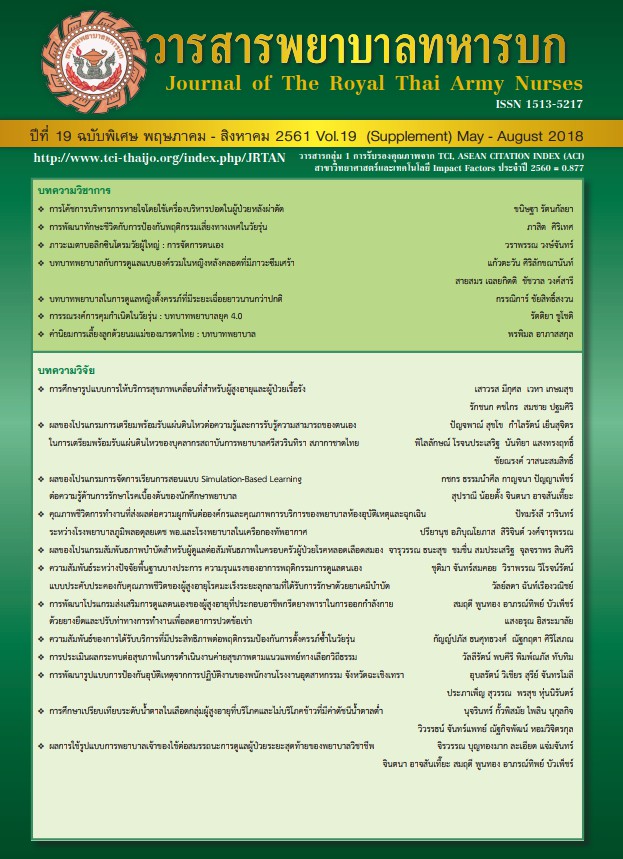Effects of Exercise Program on Depression and Cortisol Hormone in Female Adolescents with Depressive symptoms
Keywords:
Exercise Program, Depression, Cortisol Hormone, Female AdolescentsAbstract
The purpose of this quasi-experimental study was to examine the effects of exercise program on depression and cortisol hormone in female adolescents with depressive symptoms. Sixty-six high school students who met the inclusion criteria were recruited and were randomly assigned into the experimental group and the control group, n=33 for each group. The experimental group received an aerobic exercise program for 5 sessions for eight week period. Each session took about 50 minutes. The control group received only routine care. The Children’s Depression Inventory questionnaire and urinary cortisol level measurement were used to collect data at pre-posttest and one month follow-up. Descriptive statistics, independent t-test, two way repeated measure ANOVA and pairwise comparison test using Bonferroni method were employed for data analyses. The results demonstrated that the mean scores of depression and cortisol hormone between the experimental group and control group at post-test and 1 month follow-up were significantly different (p < .05). In the experimental group, the mean scores of depression and cortisol hormone at pre-test, post-test, and one-month follow-up were significantly different. For pairwise comparison between post-test and one month follow-up, cortisol hormone showed significantly decrease whereas no significant different for the mean scores of depression. From the study results, it showed that this exercise program could reduce depression in high school female adolescents with depressive symptoms. Nurses and related health personnel could apply this program in order to reduce depression in other groups of female adolescents with depressive symptoms.
References
Rushton JL, Forcier M, & Schectman RM. Epidemiology of depressive symptoms in the National Longitudinal Study of Adolescent Health. J Am Acad Child Adoles Psychiatry 2002; 41: 199-205.
Patton GC, Coffee C, Cappa C, et al. Health of the world’s adolescents : a synthesis of internationally comparable data. Lancet 2012; 379: 1665-1675.
Perera B, Torabi MR, Jayawardana G, & Pallethanna N. Depressive symptoms among adolescents in Sri Lanka. Journal of Adolescent Health 2006; 39: 144-146
Makeuatayt K, & Prasri P. A study of using group psychotherapy on depression among early adolescents high schools Bangsai District, Pranakhonsriayudthaya Province. Christian University of Thailand Journal 2008; 14(2): 153-161. (in Thai).
Beck AT. Depression: Clinical, experiment and theorical aspects. New York: Hoeber Medical Division. 1967.
Auerbach RP, Ho M-HR, & Kim JC. Identifying cognitive and interpersonal predictors of adolescent depression. J Abnorm Child Psychol 2014; 42: 913-924.
Berking M, Wirtz CM , Svaldi J , & Hofmann SG. Emotion regulation predicts symptoms of depression over five years. Behaviour Research and Therapy 2014; 57: 13-20.
Juruena MF. Early-life stress and HPA axis trigger recurrent adulthood depression. Epilepsy Behav 2014; 38: 148-159
Balchin R, Linde J, Blackhurst D, Rauch HL & Schönbächler G. Sweating away depression? The impact of intensive exercise on depression. J Affect Disord 2016; 200: 218-221
Budde H, Voelcker-Rehage C, Pietrassyk-Kendziorra S, et al. Steroid hormones in the saliva of adolescents after different exercise intensities and their influence on working memory in a school setting. Psychoneuroendocrinology 2010; 35(3): 382–91.
Nabkasorn C, Miyai, N, Sootmongkol A, Junprasert S, Yamamoto H, Arita M, & Miyashita K. Effect of physical exercise on depression, neuroendocrine stress hormone, and physiological fitness in adolescent females with depressive symptoms. European Journal of Public Health 2006; 16 (2): 179-184.
Bandura A. A Social Foundation of Thought and Action : A Social Cognitive Theory. Englewood Cliffs, NJ: Prentice-Health Inc. 1986.
Trangkrasombat U, Likampichikul D. The Children’s Depression Inventory as a screen for depression in Thai Children. J Med Assoc Thai 1997; 80: 491-496. (in Thai).
Polit DF, & Beck CT. Nursing research: Generating and assessing evidence for nursing practice (10th ed). Wolters Kluwer. 2017.
Srisatidnarakul B. The methodology in nursing research (5th ed). Bangkok. You and I Intermedia. 2010. (in Thai).
Usavapetchakul J, Kirdpitak P, & Malakul Na Ayudhaya P. The enhancement of positive strengths of adolescent students through integrative group counseling intervention. Journal of The Royal Thai Army Nurses 2015; 16(3): 79-86. (in Thai).
Mikkelsen K, Stojanovska L, Polenakovie M, et al. Exercise and mental health. Maturitas 2017; 106: 48-56.
Biddle SJH, & Asare M. Physical activity and mental health in children and adolescents: A review of reviews. British Journal of Sports Medicine 2011; 45: 886-895
Keller J, Gomez R, Williams G, et al. HPA axis in major depression: Cortisol, clinical symptomatology, and genetic variation predict cognition. Mol psychiatry 2017; 22(4): 527-536
Wolkowitz OM, Epe ES, Reus VI, & Mellon SH. Depression gets old fast : Do stress and depression accelerate cell aging? Depression and Anxiety 2010; 27: 327-338
Downloads
Published
How to Cite
Issue
Section
License
บทความหรือข้อคิดเห็นใดใดที่ปรากฏในวารสารพยาบาลทหารบกเป็นวรรณกรรมของผู้เขียน ซึ่งบรรณาธิการหรือสมาคมพยาบาลทหารบก ไม่จำเป็นต้องเห็นด้วย
บทความที่ได้รับการตีพิมพ์เป็นลิขสิทธิ์ของวารสารพยาบาลทหารบก
The ideas and opinions expressed in the Journal of The Royal Thai Army Nurses are those of the authors and not necessarily those
of the editor or Royal Thai Army Nurses Association.





